**********
"As I come over the hill on the interstate, each day from the hotel, my impression is the same as the very first one each day. I just want to make all the systems work well and fly a bit better than the day before. I don't have any grand plans or heroic speeches, just a recognition of the problems that can arise and to make sure they are handled properly. Recognizing this, I do realize that sometimes, a problem may force a complete stand down, when whatever is wrong is beyond our capabilities to fly for that day." Can you please refresh our memories as to the modifications that were made to Moonbeam prior to this years race? " The months prior to Reno did take some preparation in getting Moonbeam all configured to go racing. Added to the Mustang were water injection, spray bars for the radiators with a new coolant scoop, a modified dorsal fin, increased horizontal tail incidence, clipped wing tips, longer coolant door, smaller canopy and re-tuned engine. These changes would subsequently ensure that Moonbeam would be competitive in the fastest race field ever to enter at Reno." As we know, the qualifications and pilot certifications take place Monday through Wednesday prior to the races. What does this involve and being that this was your "first time", what type of training/instruction did you receive? " On arrival at Reno, one
week prior to the final gold races, the multitude of
briefings began as well as the last minute engine and
airframe preparations. The pilot briefings were held for
all pilots to review and to reinforce race and emergency
procedures. For the race pilots, this review was to prove
vital and After the briefings, the rookie and out-of-currency pilots were paired with race check pilots - Art Vance and Dennis Sanders - for flight checks, The entire check flight, from start engines to chock-in, was done in a race scenario. As well, our radio calls used our race number, "Race 51", rather than our N-number. My group of three rookies taxied out in race order with Art, took Off in trail, as in a race launch, and formed up immediately on Art's Mustang. We each spread out for a moment and demonstrated a roll and momentary inverted flight to our check pilot. Then it was down from altitude, onto the race course. (The race pilots talk about "the course" somewhat reverently. No one is allowed on the course without approval by the race committee organization - even after the races are over. The course is 9.187 miles in a irregular oval). On the course, Art would take us around the course several laps for a good look around. Then we would practice a pass of our check pilot, whereupon we would each individually, on his call, pull up and off the course and simulate an engine failure to deadstick landing. After this flight, if acceptable, we were cleared to go later onto the race course solo to fly ten practice laps. Once these laps were completed, we would be considered qualified race pilots. Qualified, but inexperienced!! The check flights on Monday would take the complete day to accomplish. The subsequent days were to consist of simply going out onto the course to get practice, to do power cheeks and get speed qualified. The course would be open only 90 minutes twice a day for the unlimited racers that entered to practice. For other times during the day, the biplanes, formula ones and T-6s had similar access to the course for similar purposes." So, who regulates this training/instruction? I know the FAA is present (and their regulation of flying speaks for itself ;-) but do they play a role in the actual race pilot certification?
How about telling us a bit about your first solo runs on the course & getting Moonbeam prepared and primed for the races to follow. " My first solo runs on the course were flown to check the engine power available. With water for the spray bars on board and 145 octane fuel - it was time to see how it would go. After a few warm-up laps, I pushed the power up to the firewall. To my dismay, I only got 60 inches of manifold pressure. This was not going to be enough to race in this years very fast entry field. On landing, it was realized that I did not have the broomstick installed into the carburetor to bypass the boost limit. Once my engine man Mike Nixon got that installed, it was time to go out for another try. This time it worked; I got up to 77 inches! To get to this power took not
only throttle movement, but a bit of courage. I had never
gone above 55 inches before and now I was going to push
my darling little Merlin up past that. Technically , I
had confidence that it would work. All my
"consultants" had told me that the Merlin could
easily go up to 80 inches, as it was a strong mechanical
engine design. But to do that required some preparation.
First, the The first time I got the engine up to 77 inches, I ran a few laps to get the "feel" of the power setting!! It took some personal conviction to decide to run at this fabulous manifold pressure. To accept this power, the governor was reset to 3200 rpm, At this power setting the engine did howl and the wind noise was more intense outside the canopy (or was it my breathing?!!). But the Merlin did run remarkably smooth. The smoothness was very comforting, in spite of the maelstrom outside the canopy." |
||||||

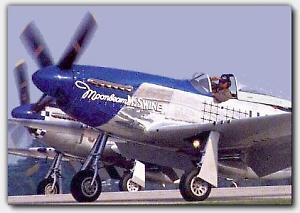
 For myself, the first impression I have at Reno
each year is the moment that I'm driving along the
interstate and get a look at the course from a distance -
I then start to imagine all that is to come during the
week and how great it will be. The anticipated sights,
sounds and aura of Reno act like an aphrodisiac,
welcoming me home. I can imagine for the competitors,
their " first impression" is somewhat
different....... Or is it? (M.K.)
For myself, the first impression I have at Reno
each year is the moment that I'm driving along the
interstate and get a look at the course from a distance -
I then start to imagine all that is to come during the
week and how great it will be. The anticipated sights,
sounds and aura of Reno act like an aphrodisiac,
welcoming me home. I can imagine for the competitors,
their " first impression" is somewhat
different....... Or is it? (M.K.) especially so for the rookie pilots. In
the "heat & passion" of flying on the race
course at high power settings, a race pilot must have in
mind already preplanned emergency procedures. For
example, if the engine quits: what do I do, where will I
go, how will I fly the airplane? All these questions have
been experienced by other race pilots at many prior Reno
race events. By sharing these past incidents with each
other in the briefings, all pilots would have an idea of
what is best to do and what others on the race course
should expect from the Mayday aircraft, ---Mayday, did I
say Mayday? Yes, this is one airport where Mayday is a
daily event, somewhat regular but absolutely serious.
especially so for the rookie pilots. In
the "heat & passion" of flying on the race
course at high power settings, a race pilot must have in
mind already preplanned emergency procedures. For
example, if the engine quits: what do I do, where will I
go, how will I fly the airplane? All these questions have
been experienced by other race pilots at many prior Reno
race events. By sharing these past incidents with each
other in the briefings, all pilots would have an idea of
what is best to do and what others on the race course
should expect from the Mayday aircraft, ---Mayday, did I
say Mayday? Yes, this is one airport where Mayday is a
daily event, somewhat regular but absolutely serious.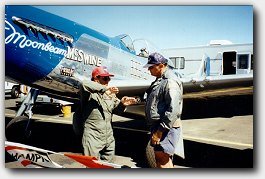 " Each morning the pilots must
attend briefings. The FAA has almost no involvement in
these, as the pilot group tends to self regulate and
manage themselves, to promote and improve safety in this
unique sport. Obviously, no FAA employee has the
experience to regulate or dictate operational issues in
this race situation. Thus, though they were present, the
FAA did very little in any of the briefings. Each pilot
is judged (and regulated) by his/her peer group in all
the race classes."
" Each morning the pilots must
attend briefings. The FAA has almost no involvement in
these, as the pilot group tends to self regulate and
manage themselves, to promote and improve safety in this
unique sport. Obviously, no FAA employee has the
experience to regulate or dictate operational issues in
this race situation. Thus, though they were present, the
FAA did very little in any of the briefings. Each pilot
is judged (and regulated) by his/her peer group in all
the race classes." engine needed higher octane fuel than
100LL. At Reno, 145 octane fuel, as well as five grades
higher with additives, is available for racing. This fuel
gets you through the 55 inch "normal" up to the
75 inch "racing" manifold pressure range. The
higher octane fuel prevents detonation problems
associated with low octane grades of fuel. As power in
the Merlin goes up into the 70-80 inch area, another
problem arises, that of high induction manifold
temperatures. These high temperatures can also cause
detonation. An easy way to solve this is by the use of a
water injection system, where a 50-50 mix of water and
alcohol is sprayed into the intake manifold to reduce the
induction temperatures. At much higher power settings the
aftercooler in a stock engine becomes ineffective (At the
"Strega" power setting of 120 to 140 inches,
the aftercooler is removed from the engine altogether!).
One can run without water injection if induction
temperatures are monitored and kept below 80 degrees
centigrade. This 80 degree limit results in a power
setting around 75 to 80 inches of manifold pressure. At
Reno, noted Lockheed Skunk Works scientist, Pete Law, was
available to check and fine tune many race engine water
injection systems. At Lockheed, Pete primarily works in
the field of thermodynamics, where he developed the
exotic fuels for the SR-71 and F-117.
engine needed higher octane fuel than
100LL. At Reno, 145 octane fuel, as well as five grades
higher with additives, is available for racing. This fuel
gets you through the 55 inch "normal" up to the
75 inch "racing" manifold pressure range. The
higher octane fuel prevents detonation problems
associated with low octane grades of fuel. As power in
the Merlin goes up into the 70-80 inch area, another
problem arises, that of high induction manifold
temperatures. These high temperatures can also cause
detonation. An easy way to solve this is by the use of a
water injection system, where a 50-50 mix of water and
alcohol is sprayed into the intake manifold to reduce the
induction temperatures. At much higher power settings the
aftercooler in a stock engine becomes ineffective (At the
"Strega" power setting of 120 to 140 inches,
the aftercooler is removed from the engine altogether!).
One can run without water injection if induction
temperatures are monitored and kept below 80 degrees
centigrade. This 80 degree limit results in a power
setting around 75 to 80 inches of manifold pressure. At
Reno, noted Lockheed Skunk Works scientist, Pete Law, was
available to check and fine tune many race engine water
injection systems. At Lockheed, Pete primarily works in
the field of thermodynamics, where he developed the
exotic fuels for the SR-71 and F-117.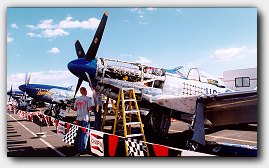 course and pulling up, would almost
assure ones capability to reach any of the three runways
at Reno Stead airport. The engine sputtered at pylon 4,
which is heading away from the airport and thus I could
not see any of the runways. But as I pulled up and toward
the enter, I could start to pick out the airport from the
distant desert glare and sage brush. With 363 MPH on the
airspeed indicator when the engine coughed, I easily
gained altitude to the center of the course. I went up so
high, up to 3500 feet AGL, that the real problem was how
to come down to the intended point of touchdown. As I
went up, I did pull the windmilling prop back to reduce
drag. Next, as airspeed dropped, I put the gear down as I
did have the airport assured. But now to fine tune the
approach, I needed to use a combination of flaps and the
prop as a speed brake to keep it on the right glide path
to touchdown on runway 8. That combination, again as
discussed in the pilot briefing, did work out beautifully
with touchdown on the end and rollout to the center
taxiway. Oh yes, the problem....too much water being
injected into the motor, making the induction temperature
too cool for the power setting - the flame in the
cylinder was simply being dowsed ), Pete Law stepped in
to readjust the water injection nozzles,
gratefully!"
course and pulling up, would almost
assure ones capability to reach any of the three runways
at Reno Stead airport. The engine sputtered at pylon 4,
which is heading away from the airport and thus I could
not see any of the runways. But as I pulled up and toward
the enter, I could start to pick out the airport from the
distant desert glare and sage brush. With 363 MPH on the
airspeed indicator when the engine coughed, I easily
gained altitude to the center of the course. I went up so
high, up to 3500 feet AGL, that the real problem was how
to come down to the intended point of touchdown. As I
went up, I did pull the windmilling prop back to reduce
drag. Next, as airspeed dropped, I put the gear down as I
did have the airport assured. But now to fine tune the
approach, I needed to use a combination of flaps and the
prop as a speed brake to keep it on the right glide path
to touchdown on runway 8. That combination, again as
discussed in the pilot briefing, did work out beautifully
with touchdown on the end and rollout to the center
taxiway. Oh yes, the problem....too much water being
injected into the motor, making the induction temperature
too cool for the power setting - the flame in the
cylinder was simply being dowsed ), Pete Law stepped in
to readjust the water injection nozzles,
gratefully!"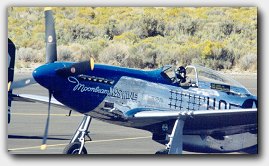 " I personally needed a few minutes
before the race to quiet down in the motorhome before
climbing on board. This may have been more physical than
mental, as I did need a bit of rest from doing all the
ramp roving prior to each heat event. We each did have to
switch gears in order to think about flying rather than
what part needs fixing while in the pits."
" I personally needed a few minutes
before the race to quiet down in the motorhome before
climbing on board. This may have been more physical than
mental, as I did need a bit of rest from doing all the
ramp roving prior to each heat event. We each did have to
switch gears in order to think about flying rather than
what part needs fixing while in the pits."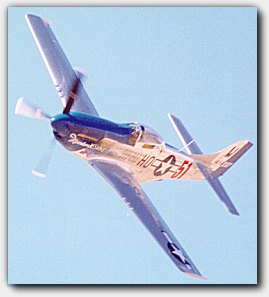 " Each heat race was flown with
eight racers. Steve Hinton provided the pace airplane in
his T-33, which produced a smoke trail to rival any old
smoker Stearman. The smoke trail aided in the racers
ability to spot, fly to and get into formation behind the
pace plane. Steve would then fly the group to the south
side of the valley, where his final turn to the left
would drive the group of racers (now in line abreast
formation) down onto the race course. The race entry was
always very exciting as the crowds would react with an
air of anxiety and anticipation. To see a group of racers
descending onto the race course with their engines all
wound up to high power was a thrilling sight.
" Each heat race was flown with
eight racers. Steve Hinton provided the pace airplane in
his T-33, which produced a smoke trail to rival any old
smoker Stearman. The smoke trail aided in the racers
ability to spot, fly to and get into formation behind the
pace plane. Steve would then fly the group to the south
side of the valley, where his final turn to the left
would drive the group of racers (now in line abreast
formation) down onto the race course. The race entry was
always very exciting as the crowds would react with an
air of anxiety and anticipation. To see a group of racers
descending onto the race course with their engines all
wound up to high power was a thrilling sight. The races were an amazing assortment of
men and machinery. The camaraderie on the ramp was just
amazing to this (and the other) newcomers. Any time
anyone had a problem or lacked some parts, every other
competitor and their Crew were always willing to lend a
hand or lone a part. Strega’s crew fixed a part for
Moonbeam one morning, (thanks to Bill Kerchenfaut.) The
1997 Reno Air races are now history. The results for the
Gold Race are documented in many aviation magazines
throughout the US. These published results don't even
begin to fully express the sweat, excitement and
satisfaction that goes into participating in the air
race.
The races were an amazing assortment of
men and machinery. The camaraderie on the ramp was just
amazing to this (and the other) newcomers. Any time
anyone had a problem or lacked some parts, every other
competitor and their Crew were always willing to lend a
hand or lone a part. Strega’s crew fixed a part for
Moonbeam one morning, (thanks to Bill Kerchenfaut.) The
1997 Reno Air races are now history. The results for the
Gold Race are documented in many aviation magazines
throughout the US. These published results don't even
begin to fully express the sweat, excitement and
satisfaction that goes into participating in the air
race.